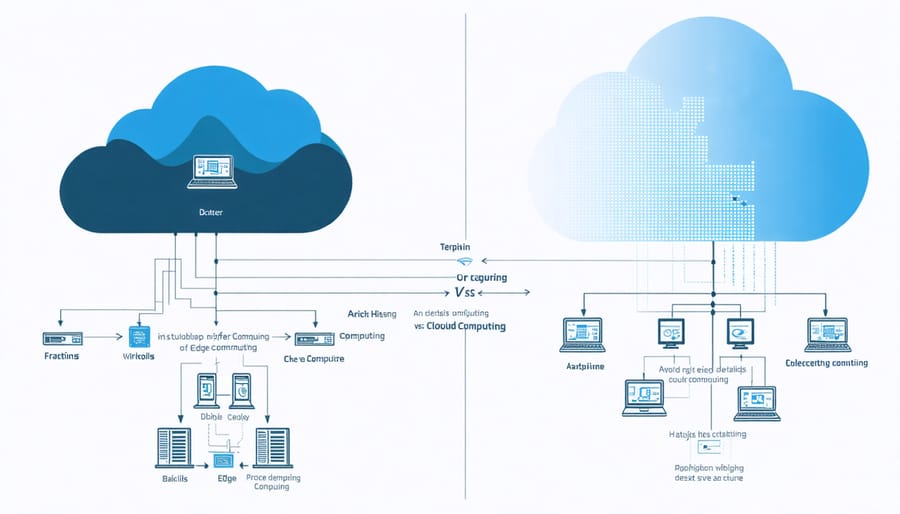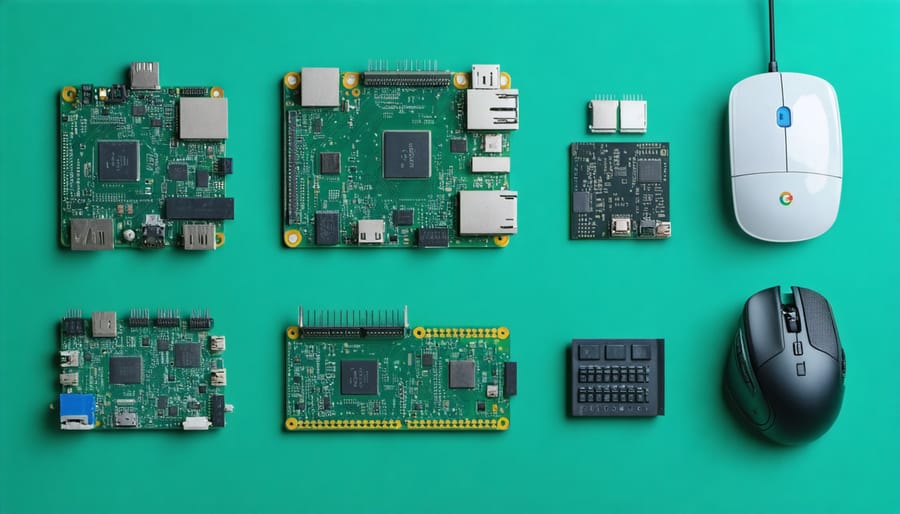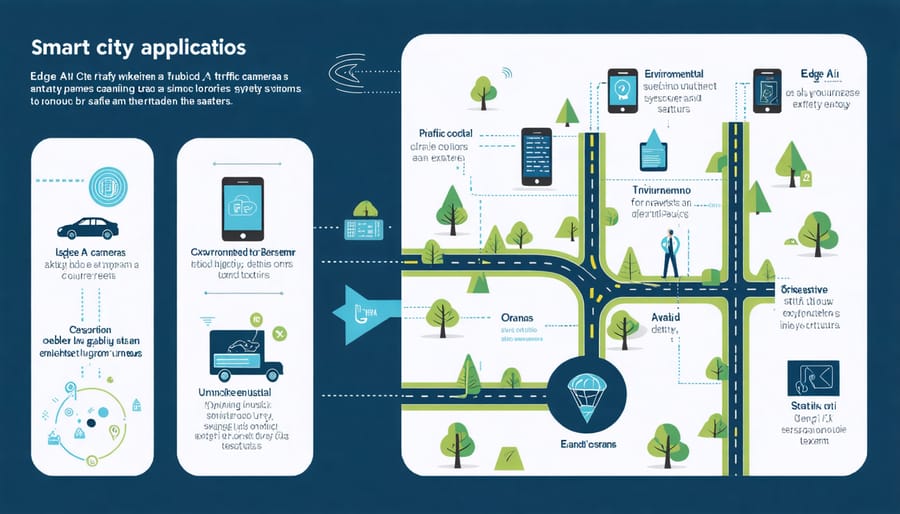Edge AI devices are revolutionizing how we process and act on data by bringing artificial intelligence directly to where it’s needed most – at the source. These powerful, compact computing systems perform complex AI operations without relying on cloud connections, enabling split-second decisions in everything from autonomous vehicles to smart manufacturing floors.
Imagine a security camera that doesn’t just record footage but instantly identifies potential threats, or a medical device that analyzes patient vitals in real-time without sending sensitive data to external servers. This is the transformative power of edge AI devices, which combine sophisticated machine learning capabilities with efficient, localized processing.
As processing power grows and AI models become more efficient, we’re witnessing a fundamental shift in how intelligent systems operate. Edge AI devices are no longer just alternatives to cloud computing – they’re becoming essential tools for organizations that demand faster response times, enhanced privacy, and reduced bandwidth consumption.
Whether you’re a developer looking to deploy your first edge AI solution or a business leader exploring ways to optimize operations, understanding these devices is crucial in today’s rapidly evolving technological landscape. Let’s explore how edge AI devices are reshaping the future of computing and why they matter for your next project.
What Makes Edge AI Devices Different

Processing Power at the Edge
Edge AI devices bring powerful processing capabilities directly to where data is generated, marking a significant shift from traditional cloud-based AI solutions. This local processing approach dramatically reduces latency, enabling real-time decision-making and faster response times for critical applications.
Modern edge devices pack impressive computational power into compact forms, utilizing specialized processors like Neural Processing Units (NPUs) and optimized AI accelerators. These components are designed for energy-efficient AI processing while maintaining high performance for tasks like image recognition, natural language processing, and sensor data analysis.
The processing capabilities of edge devices vary significantly, from simple microcontrollers running basic inference tasks to powerful edge servers handling multiple AI models simultaneously. This flexibility allows organizations to choose hardware that matches their specific needs, whether it’s a smart camera performing real-time object detection or an industrial robot making split-second decisions on the factory floor.
By processing data locally, edge AI devices can operate independently of network connectivity, ensuring consistent performance even in environments with limited or unreliable internet access. This autonomy, combined with reduced data transmission needs, makes edge AI devices ideal for applications requiring immediate responses and enhanced privacy protection.
Privacy and Security Benefits
Processing data locally on edge AI devices offers significant privacy and security advantages compared to cloud-based solutions. When data stays on your device instead of traveling to remote servers, it dramatically reduces the risk of sensitive information being intercepted or compromised during transmission.
Consider a smart security camera with edge AI capabilities. Instead of sending raw video footage to the cloud, it can process images locally, only transmitting alerts when specific events are detected. This approach keeps potentially sensitive footage secure within your premises.
Edge AI devices also help organizations comply with data protection regulations like GDPR by minimizing data movement across borders. Healthcare providers, for instance, can analyze patient data on-premises while maintaining strict privacy requirements.
Local processing eliminates the need for constant internet connectivity, reducing potential attack vectors that cybercriminals might exploit. Additionally, edge devices can continue operating even during network outages, ensuring consistent security monitoring and data protection.
By keeping sensitive data close to its source, edge AI devices create a more robust and private computing environment, making them ideal for applications where data security is paramount.
Popular Edge AI Hardware Solutions

Single Board Computers
Single board computers (SBCs) have revolutionized edge AI deployment by offering compact, affordable, and versatile platforms for running artificial intelligence applications. The Raspberry Pi, perhaps the most well-known SBC, has become a favorite among developers and enthusiasts for prototyping edge AI solutions. Its latest models, particularly the Raspberry Pi 4, provide enough computing power to run basic machine learning models while maintaining excellent power efficiency.
NVIDIA’s Jetson Nano takes edge AI capabilities a step further with its dedicated GPU, making it particularly suited for computer vision and deep learning applications. This powerful device can process multiple neural networks simultaneously while consuming as little as 5 watts of power, making it ideal for battery-powered edge devices.
Other notable options include the Google Coral Dev Board, which features a dedicated Edge TPU (Tensor Processing Unit) for accelerating machine learning inference, and the BeagleBone AI, which comes with built-in machine learning capabilities through its TI processors.
These single board computers excel in scenarios where space and power constraints are significant considerations. Common applications include smart home devices, autonomous robots, and intelligent surveillance systems. Their affordability and extensive community support make them perfect starting points for edge AI experimentation and development.
When selecting an SBC for edge AI projects, consider factors such as processing power, power consumption, available interfaces, and community support. Many of these boards also offer expansion capabilities through HATs (Hardware Attached on Top) or similar add-on boards, allowing for customization based on specific project requirements.
Specialized Edge AI Processors
Specialized processors designed specifically for AI workloads have revolutionized edge computing by offering high performance in compact, energy-efficient packages. The Google Coral, built around Google’s Edge TPU (Tensor Processing Unit), stands out for its ability to run TensorFlow Lite models with remarkable speed and efficiency. This USB-powered device can process several frames per second while consuming minimal power, making it ideal for computer vision applications.
Intel’s Neural Compute Stick 2 (NCS2) represents another breakthrough in portable AI acceleration. Based on the Movidius Myriad X VPU architecture, it enables developers to prototype and deploy deep learning applications quickly. The stick-like form factor allows easy connection to any device with a USB port, effectively transforming ordinary computers into AI-capable machines.
Other notable players in this space include the Nvidia Jetson series, which combines powerful GPU capabilities with dedicated AI acceleration, and the Qualcomm Neural Processing SDK, which leverages smartphone-grade processors for AI tasks. These specialized processors typically support popular frameworks like TensorFlow, PyTorch, and Caffe, making them accessible to developers already familiar with these tools.
What sets these dedicated AI accelerators apart is their optimization for specific types of neural network operations, allowing them to process AI workloads more efficiently than general-purpose processors. This specialization results in faster inference times and lower power consumption, crucial factors for edge deployment scenarios where resources are limited.
Real-World Applications
Industrial IoT and Manufacturing
In modern manufacturing facilities, edge AI devices are revolutionizing operations through intelligent predictive maintenance and quality control systems. These smart devices continuously monitor equipment performance, analyzing vibration patterns, temperature fluctuations, and other vital metrics to detect potential failures before they occur.
For instance, smart sensors equipped with edge AI capabilities can perform real-time AI analysis of production line components, instantly identifying unusual wear patterns or performance degradation. This proactive approach helps manufacturers reduce unexpected downtime and optimize maintenance schedules, resulting in significant cost savings.
Quality control applications have also been transformed by edge AI devices. High-speed cameras with built-in AI processors can inspect thousands of products per minute, detecting defects that might be invisible to the human eye. These systems can identify issues like incorrect product assembly, packaging flaws, or surface imperfections with remarkable accuracy.
Consider an automotive manufacturing plant where edge AI devices monitor welding quality. The systems analyze factors such as temperature distribution, weld penetration, and surface finish in milliseconds, ensuring every weld meets strict quality standards. Similar applications exist in electronics manufacturing, where AI-powered visual inspection systems verify circuit board assembly and component placement.
The impact of these implementations extends beyond quality improvement. By processing data locally, edge AI devices help manufacturers maintain production efficiency while reducing bandwidth costs and latency issues associated with cloud-based solutions. This combination of improved quality control and operational efficiency makes edge AI an invaluable tool in modern industrial settings.
Smart Cities and Infrastructure
Edge AI devices are revolutionizing how cities manage their infrastructure and enhance public safety through real-time processing and decision-making capabilities. In traffic management, smart cameras equipped with edge AI analyze traffic patterns instantly, adjusting signal timings to optimize flow and reduce congestion. These systems can detect accidents, unauthorized parking, or vehicle breakdowns, enabling quick response from authorities without relying on human monitoring.
Public transportation benefits from edge AI through smart ticketing systems and passenger counting devices that help optimize bus and train schedules based on real-time demand. These devices process data locally, ensuring minimal latency and reliable service even when network connectivity is limited.
In the realm of public safety, edge AI-powered surveillance systems can identify suspicious activities, unauthorized access to restricted areas, or emergency situations requiring immediate attention. For instance, smart streetlights equipped with edge AI can detect unusual sounds like gunshots or crashes, automatically alerting emergency services while adjusting lighting levels to assist first responders.
Urban infrastructure maintenance has also been transformed by edge AI devices. Smart sensors monitor structural health of bridges, buildings, and roads, processing data on-site to detect potential issues before they become critical. These devices can measure vibrations, stress levels, and environmental conditions, providing early warning signs of maintenance needs.
Weather monitoring stations with edge AI capabilities help cities prepare for severe weather events by processing local atmospheric data and combining it with broader weather patterns. This enables faster, more accurate responses to environmental challenges, from adjusting traffic flow during storms to managing energy consumption across city facilities.

Getting Started with Edge AI Development
Choosing the Right Hardware
When selecting edge AI devices, several crucial factors need to be balanced to ensure optimal performance for your specific use case. Processing power is paramount – you’ll need to determine whether your AI models require GPU acceleration or if CPU-based processing will suffice. For image recognition or complex neural networks, devices with dedicated neural processing units (NPUs) often provide the best performance-to-power ratio.
Power consumption is another critical consideration, especially for battery-operated or remote deployments. Some devices might offer impressive processing capabilities but consume too much power for practical field use. Consider whether your device needs to run continuously or can operate intermittently to conserve energy.
Memory and storage requirements should align with your model size and data handling needs. While some edge AI applications can run with just a few megabytes of RAM, others might require several gigabytes for efficient operation. Similarly, storage capacity affects how much data you can process and store locally.
Connectivity options are essential for device management and data transmission. Whether you need Wi-Fi, Bluetooth, cellular, or ethernet capabilities depends on your deployment environment and data sharing requirements. Also consider physical factors like size, durability, and operating temperature range, particularly for industrial or outdoor applications.
Cost considerations should include not just the initial hardware investment, but also deployment, maintenance, and potential scaling needs. Sometimes, a more expensive device might prove more cost-effective in the long run due to better reliability and performance.
Development Tools and Frameworks
The landscape of edge AI development is rich with tools and frameworks that make deploying machine learning models to edge devices more accessible than ever. TensorFlow Lite stands out as a popular choice, offering a lightweight solution specifically designed for mobile and embedded devices. It allows developers to optimize their models for edge deployment while maintaining good performance.
PyTorch Mobile provides another robust option, particularly appealing to developers already familiar with the PyTorch ecosystem. It offers seamless model conversion and optimization features that help ensure efficient execution on edge devices.
For hardware-specific development, NVIDIA’s JetPack SDK provides a comprehensive suite of tools for their Jetson platform, including libraries, APIs, and samples that simplify edge AI development. Intel’s OpenVINO toolkit similarly enables optimization of deep learning models for Intel hardware.
Edge-specific IDEs like Edge Impulse and Arduino IDE have also gained traction, offering intuitive interfaces for developing and testing edge AI applications. These platforms often include built-in support for popular microcontrollers and development boards.
Cloud providers have joined the ecosystem with their own tools: AWS IoT Greengrass, Azure IoT Edge, and Google Cloud IoT Edge all offer integrated development environments that support the entire edge AI development lifecycle, from model training to deployment and monitoring.
Edge AI devices have fundamentally transformed how we process and utilize artificial intelligence in our daily lives. By bringing computational power closer to data sources, these devices have opened new possibilities in various sectors, from smart manufacturing to healthcare and autonomous vehicles. The reduced latency, enhanced privacy, and improved efficiency they offer have made them indispensable in modern technological infrastructure.
Looking ahead, the future of edge AI devices appears increasingly promising. As chip manufacturers continue to develop more powerful and energy-efficient processors, we can expect to see even more capable devices that can handle increasingly complex AI models. The integration of 5G technology will further enhance the capabilities of edge AI systems, enabling faster communication and more sophisticated distributed computing networks.
Industry experts predict substantial growth in edge AI adoption, with particular emphasis on IoT applications, smart cities, and personalized consumer devices. We’re likely to witness the emergence of more specialized edge AI hardware designed for specific use cases, alongside improvements in edge AI software frameworks that make deployment easier and more accessible.
However, challenges remain in areas such as standardization, security, and power consumption. The industry will need to address these concerns while continuing to innovate. Despite these challenges, edge AI devices are poised to play an even more crucial role in shaping our technological future, making AI more accessible, efficient, and practical for everyday applications.

